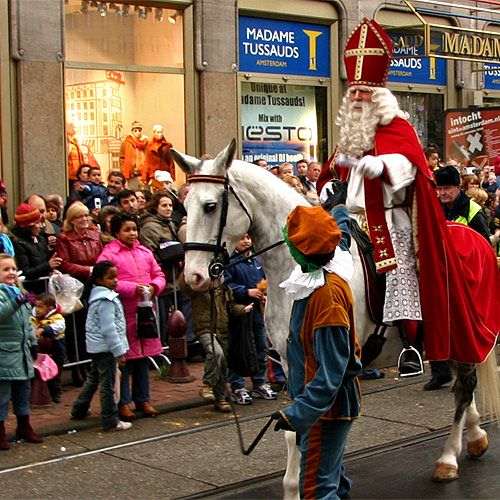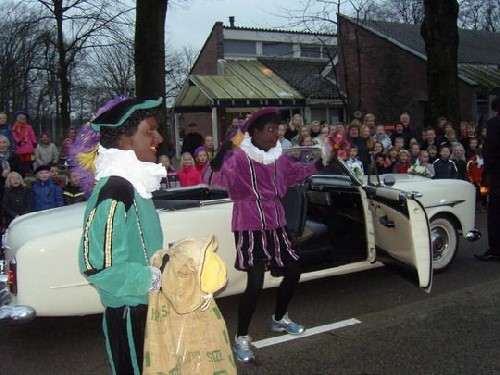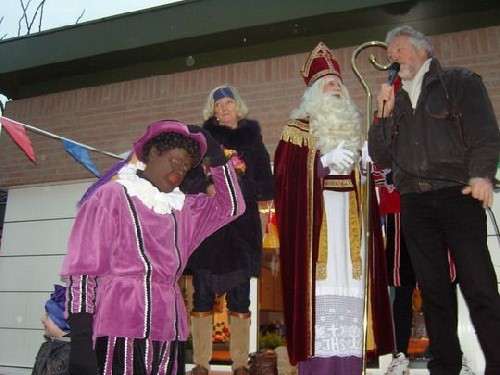|
Re: Packard and Sinterklaas!
|
||||
|---|---|---|---|---|
|
Forum Ambassador

|
Tom, Thanks for the photos. My wife who is Dutch thoroughly enjoyed the photos. I have been to the Netherlands five times and enjoyed every time I went although never on December 5th so I have always missed Sinterklass and Zwarte Piet. A lovely country.
Posted on: 2009/12/4 13:58
|
|||
|
______________________________________________
Dave |
||||
|
||||
|
Re: Packard and Sinterklaas!
|
||||
|---|---|---|---|---|
|
Just can't stay away
|
Thanks Dave! The next time you visit The Netherlands, you should visit Twente.
Groeten aan je vrouw! (kind regards to your wife). Tom
Posted on: 2009/12/4 15:19
|
|||
|
||||
|
Re: Packard and Sinterklaas!
|
||||
|---|---|---|---|---|
|
Home away from home
|
[quote]
TW wrote: In The Netherlands we celebrate "Sinterklaas" on the fifth of December. This old man chooses a Packard Convertible to bring him and his servants ("Zwarte Piet") to the schools where the children expect him. I for one would be interested in how this event came to be. Interesting looking characters. Something adapted from the Dutch East Indies?
Posted on: 2009/12/4 15:57
|
|||
|
We move toward
And make happen What occupies our mind... (W. Scherer) |
||||
|
||||
|
Re: Packard and Sinterklaas!
|
||||
|---|---|---|---|---|
|
Forum Ambassador
|
Quote:
JW wrote:......Interesting looking characters. Something adapted from the Dutch East Indies? Especially the blue and silver runners on the guy in purple? Probably made in Indonesia.
Posted on: 2009/12/4 16:04
|
|||
|
Mal
/o[]o\ ====  Bowral, Southern Highlands of NSW, Australia "Out of chaos comes order" - Nietzsche. 1938 Eight Touring Sedan - SOLD 1941 One-Twenty Club Coupe - SOLD 1948 Super Eight Limo, chassis RHD - SOLD 1950 Eight Touring Sedan - SOLD What's this?  Put your Packard in the Packard Vehicle Registry! Here's how! Any questions - PM or email me at ozstatman@gmail.com |
||||
|
||||
|
Re: Packard and Sinterklaas!
|
||||
|---|---|---|---|---|
|
Just can't stay away
|
It's a long and old story, but here it is:
Sinterklaas The Feast of Sinterklaas, or St. Nicholas, is an annual event which has been uniquely Dutch and Flemish for centuries. St. Nicholas' Feast Day, December 6th, is observed in most Roman Catholic countries primarily as a feast for small children. But it is only in the Low Countries - especially in the Netherlands - that the eve of his feast day (December 5th) is celebrated nationwide by young and old, christian and non-christian, and without any religious overtones. Although Sinterklaas is always portrayed in the vestments of the bishop he once was, his status as a canonized saint has had little to do with the way the Dutch think of him. Rather, he is a kind of benevolent old man, whose feast day is observed by exchanging gifts and making good-natured fun of each other. It so happens that the legend of St. Nicholas is based on historical fact. He did actually exist. He lived from 271 A.D. to December 6th, 342 or 343. His 4th century tomb in the town of Myra, near the city of Anatolia in present-day Turkey, has even been dug up by archaeologists. This is his story: Born of a wealthy family, Nicholas was brought up as a devout Christian. When his parents died of an epidemic, he distributed his wealth among the poor and became a priest. Later he became Archbishop of Myra, and it is from here that the fame of his good deeds began to spread across the Mediterranean. Desperate sailors who called upon the Good Bishop to calm stormy seas were heard; prison walls crumbled when victims of persecution prayed to him. He saved young children from the butcher's knife and dropped dowries into the shoes of penniless maidens. Over time, St. Nicholas became the patron saint of sailors and merchants, and especially of children. After his death, the cult of St. Nicholas spread rapidly via southern Italy throughout the rest of the Mediterranean and eventually to coastal towns along the Atlantic and the North Sea. In the 12th and 13th centuries, Holland built no fewer than 23 churches dedicated to St. Nicholas, many of which are still standing. Amsterdam adopted St. Nicholas as its patron saint, and Rome decreed that December 6th, the anniversary of his death, should be his official Feast Day. St. Nicholas' strong influence in the Low Countries - an area heavily engaged in trade and navigation - was primarily due to his role as patron of sailors and merchants. However, his fame as protector of children soon took precedence. In the 14th century, choir boys of St. Nicholas churches were given some money and the day off on December 6th. Somewhat later, the pupils of convent schools would be rewarded or punished by a monk dressed up as the Good Bishop, with his long white beard, his red mantle and mitre (bishop's hat) and his golden crosier (bishop's staff) - just as he is still presented today. All Dutch children know that Sinterklaas (the name is a corruption of Sint Nikolaas) lives in Spain. Exactly why he does remains a mystery, but that is what all the old songs and nursery rhymes say. Whatever the case may be, in Spain he spends most of the year recording the behaviour of all children in a big red book, while his helper Black Peter stocks up on presents for next December 5th. In the first weeks of November, Sinterklaas gets on his white horse, Peter ("Piet") swings a huge sack full of gifts over his shoulder, and the three of them board a steamship headed for the Netherlands. Around mid-November they arrive in a harbour town - a different one every year - where they are formally greeted by the Mayor and a delegation of citizens. Their parade through town is watched live on television by the whole country and marks the beginning of the "Sinterklaas season". The old bishop and his helpmate are suddenly everywhere at once. At night they ride across Holland's' rooftops and Sinterklaas listens through the chimneys to check on the children's behaviour. Piet jumps down the chimney flues and makes sure that the carrot or hay the children have left for the horse in their shoes by the fireplace is exchanged for a small gift or some candy. During the day, Sinterklaas and Piet are even busier, visiting schools (not always in a Packard), hospitals, department stores, restaurants, offices and many private homes. Piet rings doorbells, scatters sweets through the slightly opened doors and leaves basketfuls of presents by the front door. How do they manage to be all over the Netherlands at once? This is thanks to the so-called "hulp-Sinterklazen", or Sinterklaas helpers, who dress up like the bishop and Black Peter and help them perform their duties. Children who become wise to these simultaneous "Sint-sightings" are told that since Sinterklaas cannot indeed be in two places at once, he gets a little help from his uncanonized friends. The Dutch are busy too - shopping for, and more importantly, making presents. Tradition demands that all packages be camouflaged in some imaginative way, and that every gift be accompanied by a fitting poem. This is the essence of Sinterklaas: lots of fun on a day when people are not only allowed, but expected, to make fun of each other in a friendly way. Children, parents, teachers, employers and employees, friends and co-workers tease each other and make fun of each others' habits and mannerisms. Another part of the fun is how presents are hidden or disguised. Recipients often have to go on a treasure hunt all over the house, aided by hints, to look for them. They must be prepared to dig their gifts out of the potato bin, to find them in a jello pudding, in a glove filled with wet sand, in some crazy dummy or doll. Working hard for your presents and working even harder to think up other peoples' presents and get them ready is what the fun is all about. The original poem accompanying each present is another old custom and a particularly challenging one. Here the author has a field day with his subject (the recipient of the gift). Foibles, love interests, embarrassing incidents, funny habits and well-kept secrets are all fair game. The recipient, who is the butt of the joke, has to open his/her package in public and read the poem aloud amid general hilarity. The real giver is supposed to remain anonymous because all presents technically come from Sinterklaas, and recipients say out loud "Thank you, Sinterklaas!", even if they no longer believe in him. Towards December 5th, St. Nicholas poems pop up everywhere in the Netherlands: in the press, in school, at work and in both Houses of Parliament. On the day of the 5th, most places of business close a bit earlier than normal. The Dutch head home to a table laden with the same traditional sweets and baked goods eaten for St. Nicholas as shown in the 17th-century paintings of the Old Masters. Large chocolate letters - the first initial of each person present - serve as place settings. They share the table along with large gingerbread men and women known as "lovers". A basket filled with mysterious packages stands close by and scissors are at hand. Early in the evening sweets are eaten while those gathered take turns unwrapping their gifts and reading their poems out loud so that everyone can enjoy the impact of the surprise. The emphasis is on originality and personal effort rather than the commercial value of the gift, which is one reason why Sinterklaas is such a delightful event for young and old alike. Attach file:  (51.54 KB) (51.54 KB)
Posted on: 2009/12/4 16:27
|
|||
|
||||
|
Re: Packard and Sinterklaas!
|
||||
|---|---|---|---|---|
|
Home away from home
|
TW, thanks for sharing this holiday story. What a nice tradition the Dutch have for this time of year.
Posted on: 2009/12/4 16:41
|
|||
|
We move toward
And make happen What occupies our mind... (W. Scherer) |
||||
|
||||











